NOTES
ABOUT THIS PUBLICATION
This publication brings together statistics and indicators for deaths, including perinatal deaths registered in Australia. These statistics have been compiled from data made available to the Australian Bureau of Statistics (ABS) by the Registrar of Births, Deaths and Marriages in each state or territory.
Deaths from external causes are attributed to the event leading to the fatal injury as described in Chapter XX of International Classification of Diseases and Related Health Problems Revision 10 (ICD-10). Data relating to Chapter XIX, Injury, poisoning and certain other consequences of external causes, refer to the nature of injury and are not relevant to underlying causes of death.
INQUIRIES
For further information about these and related statistics, contact the National Information and Referral Service on 1300 135 070.
SUMMARY OF FINDINGS
SECTION 1 UNDERLYING CAUSE OF DEATH
INTRODUCTION
All deaths registered in 2003 have been coded using the tenth revision of the International Classification of Diseases and Related Health Problems (ICD-10) as released by the World Health Organization. For further explanation on cause of death classification and comparability with the previous version, ICD-9 refer to Explanatory Notes, paragraphs 13-19 and Appendix 5.
CAUSES OF DEATH
There were 132,292 deaths registered in 2003. Males comprised 51.7% of all deaths (68,330) registered in 2003, compared with 51.5% of deaths in 2002 and 52.0% of registered deaths in 2001. Female deaths comprised 48.3% of all deaths (63,962) in 2003 compared with 48.5% of all deaths in 2002 and 48.1% of all deaths registered in 2001.
The standardised death rate recorded in 2003 was 642 deaths per 100,000 population, 19.7% lower than the standardised death rate of 800 deaths per 100,000 population for 1993. The standardised death rate for males in 2003 was 792 per 100,000, compared with 1020 deaths per 100,000 in 1993. In the same period female standardised death rates have decreased from 635 per 100,000 population to 523 per 100,000.
The Northern Territory recorded the highest standardised death rate (892 deaths per 100,000 population) in 2003, while the ACT recorded the lowest rate (583 deaths per 100,000 population). While the Northern Territory had the highest death rate, it also experienced the largest decline of any state or territory between 1993 and 2003, decreasing by 24.0%.
Malignant neoplasms were the main underlying cause of 37,558 deaths, comprising 28.4% of all deaths in 2003. In 2002, Malignant neoplasms (37,622) comprised a slightly lower share of all deaths with 28.1% of all causes. Ischaemic heart diseases was the underlying cause of 25,439 deaths in 2003, and 26,063 deaths in 2002. These numbers represented 19.5% and 19.2% of all deaths in 2002 and 2003 respectively. As the graph below shows, the difference in the proportion of deaths due to Malignant neoplasms and Ischaemic heart diseases continues to widen since 1993. The proportion of deaths due to Ischaemic heart diseases has consistently decreased from 24.5% over this period, while the proportion of deaths due to Malignant neoplasms has increased from 26.9%.
DEATHS, BY SELECTED CAUSE - AUSTRALIA
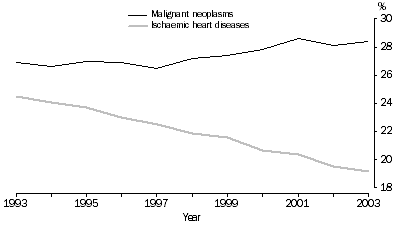
MALIGNANT NEOPLASMS
The standardised death rate from Malignant neoplasms was 183 deaths per 100,000 population in 2003 compared to 209 per 100,000 in 1993, representing a decrease of 12.1%. While there have been decreases for most types of cancers between 1993 and 2003, the standardised deaths rates have increased for the cancers of the Oesophagus (+5.8%), Liver and intrahepatic bile ducts (+41.9%) and Melanoma of skin (+1.9%).
For males, the standardised death rate from Malignant neoplasms decreased 15.0% from 276 to 234 per 100,000 population between 1993 and 2003. The corresponding decrease for females was 10.8%, with rates of 163 per 100,000 in 1993 and 145 per 100,000 in 2003. Increases in the standardised death rate in particular types of cancers for males between 1993 and 2003 include; Oesophagus (+5.1%), Liver and intrahepatic bile ducts (+37.5%) and Melanoma of skin (+2.5%). For females, the standardised death rate increased for cancer types Liver and intrahepatic bile ducts (+56.3%), Pancreas (+5.1%), Trachea, bronchus and lung (+5.7%) and Melanoma of skin (+6.2%).
STANDARDISED DEATH RATES, Selected Malignant neoplasms-Males
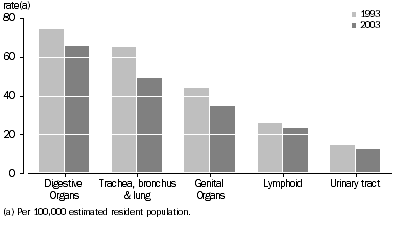 STANDARDISED DEATH RATES, Selected Malignant neoplasms -Females
STANDARDISED DEATH RATES, Selected Malignant neoplasms -Females
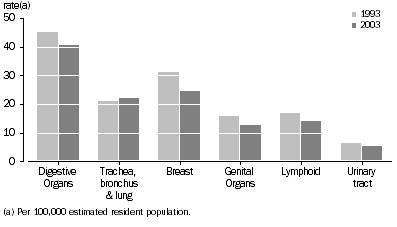
EXTERNAL CAUSES
External causes relate to deaths from accidents, poisonings and violence. In 2003, External causes accounted for 7,749 deaths, or 5.6% of all registered deaths. The standardised death rate was 39 per 100,000 of population. The corresponding rate for 1993 was 41 per 100,000. The standardised death rate has continued to fall for Transport accidents, from 26.7 per 100,000 population in 1993 to 24.1 per 100,000 in 2003.
The standardised death rate in 2003 from Intentional self-harm (suicide) was 17.7 per 100,000 males and 4.7 per 100,000 females, which were both decreases from the respective rates recorded in 2002 (18.8 per 100,000 males and 5.0 per 100,000 females). There were 2,213 deaths attributed to suicide registered in 2003, 4.6% less than in 2002.
DEATHS OF INDIGENOUS PEOPLE
Data on deaths of Aboriginal and Torres Strait Islander Australians are affected by differing levels of coverage across states and territories of deaths identified as Indigenous (see Explanatory Notes, paragraph 23, for further information). Care should be exercised in analysing these data, particularly in making comparisons across states and territories and between the Indigenous and non-Indigenous data. The proportions presented in Table 1.9 have not been adjusted to account for the different age structures of the Indigenous and non-Indigenous populations.
In the selected states and territory for which data are presented in Table 1.9, Indigenous and non-Indigenous persons in 2003 had the same two main causes of death: Malignant neoplasms and Ischaemic heart diseases, although the proportional distribution of these deaths differed across the two populations.
While direct comparisons across these jurisdictions are subject to the variable coverage of reported Indigenous deaths, it is apparent that deaths from External causes was also a major contributor to deaths among Indigenous people in these jurisdictions, ranging from approximately 12% in New South Wales to 20% in South Australia.
YEARS OF POTENTIAL LIFE LOST (YPLL)
A measure of premature mortality is YPLL for deaths occurring between the ages of 1 year and 78 years inclusive. (Refer to the Technical Note for further detail). In 2003, the estimates of YPLL were 637,067 years for males and 349,445 years for females for all causes of death.
There are significant differences in YPLL's between the sexes for particular underlying causes. The proportion of YPLL lost from Malignant neoplasms for males aged 1-78 years was 30.1% and for females in this age group it was 44.2%. However, the proportion of Malignant neoplasms was reported in 37.4% of all male deaths and 43.9% of all female deaths aged 1-78 years.
Similarly, in males aged 1-78 years, prostate cancer was reported as the underlying cause in 3.4% of all deaths but comprised only 1.6% of the total YPLL, whereas for females in the same age group, breast cancer was reported as the underlying cause in 8.2% of all deaths representing 10.3% of total YPLL for females.
PERCENTAGE OF YEARS OF POTENTIAL LIFE LOST, Selected underlying causes
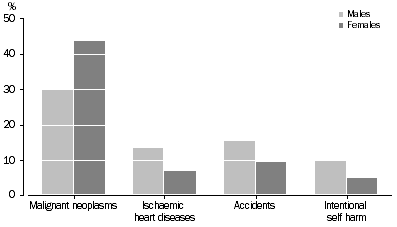
S E C T I O N 2 M U L T I P L E C A U S E S O F D E A T H
INTRODUCTION
Multiple causes of death include all causes and conditions reported on the death certificate (i.e. both underlying and associated causes; see Glossary for further details). Deaths due to External causes are those which occur as a result of accidents, poisonings and/or violence. They are classified according to the event, leading to the fatal injury (such as an Accidental fall). Multiple cause data for External causes include the nature of injury or poisoning, as well as any other causes reported on the death certificate.
NUMBER OF MULTIPLE CAUSES
For the 132,292 deaths registered in 2003, there were 398,559 causes reported giving a mean of 3.0 causes per death. In 19.4% of all deaths, only one cause was reported, whereas 55.9% of deaths were reported with three or more causes. The mean number of causes reported per death varies with age, sex and underlying cause of death.
SELECTED MULTIPLE CAUSES
In 2003, Malignant neoplasms comprised 28.4% of all underlying cause of death, and yet it contributed to 39.0% of all deaths as an underlying or associated cause. Similarly, 19.2% of all deaths had Ischaemic heart diseases as the underlying cause, but it was found to contribute to 36.0% of all deaths as either an underlying or associated cause. The following table lists the top ten multiple causes of death (underlying and associated causes) appearing on death certificates for deaths registered in 2003, and their corresponding ranking in terms of underlying causes.
SELECTED MULTIPLE CAUSES OF DEATH |
|  |
 | Multiple causes(a) |  |  | Underlying cause |  |  |
| Cause of death and ICD code | no. | % | rank | % | rank |  |
|  |
| Malignant neoplasms (C00-C97) | 51,567 | 39.0 | 1 | 28.4 | 1 |  |
| Ischaemic heart diseases (I20-I25) | 47,582 | 36.0 | 2 | 19.2 | 2 |  |
| Cerebrovascular diseases (I60-I69) | 22,985 | 17.4 | 3 | 9.3 | 3 |  |
| Influenza and pneumonia (J10-J18) | 18,692 | 14.1 | 4 | 2.7 | 6 |  |
| Heart Failure (I50) | 17,077 | 12.9 | 5 | 1.8 | 10 |  |
| Hypertensive diseases (I10-I15)) | 15,022 | 11.4 | 6 | 1.0 | 20 |  |
| Renal failure (N17-N19) | 14,939 | 11.3 | 7 | 1.5 | 12 |  |
| Chronic lower respiratory diseases (J40-J47) | 14,496 | 11.0 | 8 | 4.5 | 4 |  |
| Diabetes mellitus (E10-E14) | 11,410 | 8.6 | 9 | 2.6 | 7 |  |
| Organic, including symptomatic, mental disorders (F00-F09) | 10,976 | 8.3 | 10 | 2.0 | 8 |  |
| Deaths from all causes | 132,292 | 100.0 | - | 100.0 | - |  |
|  |
| - nil or rounded to zero (including null cells) |
| (a) Number of deaths and percentages may add to more than totals because a death certificate can report more than one leading multiple cause. |
RELATIONSHIP OF CAUSES
The following table illustrates relationships between the various causes of death in 2003. Malignant neoplasms, the most prevalent underlying cause (37,558 deaths), was reported alone in 37.6% of cases and is less likely to be reported with other more prevalent causes. In contrast, Renal failure was reported alone as the underlying cause in only 7.3% of the 1,986 deaths attributed to this cause. It was reported more frequently with associated causes of Ischaemic heart diseases and Heart failure.
SELECTED UNDERLYING CAUSES WITH ASSOCIATED CAUSES(a) |
|  |
 | Selected underlying cause
| Reported with selected associated cause
|  |
 | Total no. of deaths | Reported alone | Malignant neoplasms (C00-C97) | Ischaemic heart diseases (I20-I25) | Cerebro- vascular diseases (I60-I69) | Chronic lower respiratory diseases (J40-J47) | Influenza and pneumonia (J10-J18) | Heart failure (I50) | Renal failure (N17-N19) |  |
 | no. | % | % | % | % | % | % | % | % |  |
|  |
| Malignant neoplasms (C00-C97) | 37,558 | 37.6 | - | 7.7 | 3.6 | 6.3 | 8.0 | 3.6 | 5.9 |  |
| Ischaemic heart diseases (I20-I25) | 25,439 | 10.9 | 6.0 | - | 9.4 | 10.1 | 5.8 | 23.6 | 10.6 |  |
| Cerebrovascular diseases (I60-I69) | 12,240 | 16.8 | 4.7 | 10.8 | - | 3.7 | 15.8 | 5.4 | 4.4 |  |
| Chronic lower respiratory diseases (J40-J47) | 5,985 | 6.9 | 7.3 | 18.9 | 5.5 | - | 34.2 | 17.3 | 7.9 |  |
| Influenza and pneumonia (J10-J18) | 3,566 | 32.0 | 1.1 | 14.2 | 2.7 | 1.2 | - | 10.2 | 9.8 |  |
| Heart failure (I50) | 2,432 | 14.0 | 5.6 | - | 7.7 | 11.6 | 23.4 | - | 20.5 |  |
| Renal failure (N17-N19) | 1,986 | 7.3 | 5.6 | 26.4 | 8.0 | 7.6 | 14.6 | 28.5 | - |  |
|  |
| - nil or rounded to zero (including null cells) |
| (a) This table presents data for selected causes only. Therefore numbers and percentages due to reporting of underlying cause with selected associated causes do not add to totals. |
EXTERNAL CAUSES
In 2003, there were 7,749 deaths due to External causes, with an average of 3.2 causes coded per each of these deaths. Deaths as a result of Accidental falls averaged 3.5 multiple causes, reflecting the number of injuries sustained. In 2003, Transport accidents accounted for 27.1% of all injuries reported for deaths due to External causes, with 45.4% of these injuries being to the head or thorax. Intentional self-harm accounted for 25.3% of total injuries due to External causes, and of these injuries, Asphyxiation was the most common (37.5%).
S E C T I O N 3 P E R I N A T A L D E A T H S
INTRODUCTION
Perinatal deaths comprise stillbirths (fetal deaths) and deaths of infants within the first 28 days of life (neonatal deaths). In this publication (and in previous editions since 1997), these deaths are defined to include infants and fetuses weighing at least 400 grams or having a gestational age of 20 weeks.
The exception to this is Table 3.1 which is based on the World Health Organisation recommended definition and includes infants and fetuses weighing at least 500 grams or having a gestational age of 22 weeks. Refer to Explanatory Notes, paragraphs 6-10 for further information on perinatal death statistics. Further tables based on either definition are available from the ABS.
TRENDS IN PERINATAL DEATHS
In 2003, there were 2,020 perinatal deaths registered in Australia, compared with 2,019 registered in 2002. The number of fetal deaths in 2003 was 1,288, an increase of 3.9% on the number registered in 2002 (1,240). Neonatal deaths have decreased from 779 in 2002 to 732 in 2003. Since 1993, the number of registered perinatal deaths has decreased by 18.1% (447). The proportion of perinatal deaths where birth weight was less than 1000 grams was 47.9% in 2003, while 46.7% of deaths had a gestational period of less than 28 weeks.
In 2003, the sex ratio of male perinatal deaths for every 100 female perinatal deaths was 123, compared with a ratio of 122 recorded in 2002.
The perinatal death rate remained constant between 2002 and 2003 at 8.0 deaths per 1,000 total relevant births (see Glossary, death rates for further information). Between 1993 and 2003, the perinatal death rate declined from 9.4 to 8.0 deaths per 1,000 total relevant births. In the same period, the fetal rate declined by 10.5% (5.7 to 5.1 per 1,000 total relevant births), while the neonatal rate fell to the lowest ever recorded (2.9 per 1,000 total relevant births). During the last ten years the highest level was recorded in 1993 and 1994 (3.7 per 1,000 total relevant births).
TRENDS IN PERINATAL DEATHS (a)
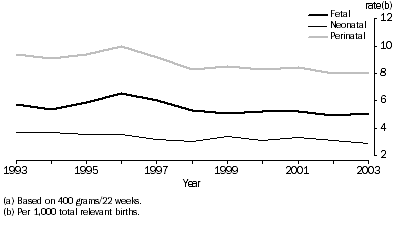
Northern Territory had the highest perinatal death rate in 2003 (15.2 per 1,000 total relevant births), while New South Wales had the lowest rate (6.8 per 1,000 total relevant births).
AGE OF MOTHER
PERINATAL DEATHS, rates - age of mother
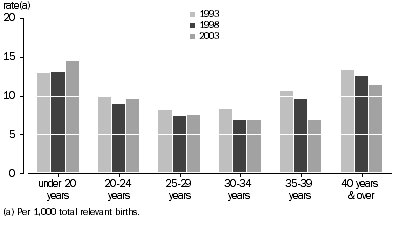
In 2003, the proportion of perinatal deaths registered to mothers aged less than 20 years was 7.8% compared to 4.6% for mothers aged 40 years or more.
While the overall perinatal death rate has decreased by 14.9% over the last ten years, this is not consistent across all age groups. In particular, the perinatal death rate of 14.5 per 1,000 total relevant births in 2003 for mothers aged less than 20 years is 12.4% higher than the 1993 rate of 12.9 per 1,000 total relevant births.
CONDITION IN FETUS/INFANT
In 2003, 30.7% of perinatal deaths were not assigned a specific cause of death in the fetus/infant. Medical certifiers are often unwilling or unable to provide an accurate cause of death without the assistance of an autopsy. The absence of a specific cause of death largely affects fetal deaths. While 47.3% of all fetal deaths registered in 2003 reported no specific cause, the corresponding figure for neonatal deaths was 1.6%.
Respiratory and cardiovascular disorders, specific to the perinatal period, accounted for 17.0% of perinatal deaths, while Disorders related to length of gestation and fetal growth contributed a further 14.2%.
Conditions reported in fetal deaths registered in 2003 include Congenital malformations, deformations and chromosomal abnormalities (14.2%), Respiratory and cardiovascular disorders specific to the perinatal period (14.2%) and Disorders related to length of gestation and fetal growth (8.8%). In comparison, Congenital malformations, deformations and chromosomal abnormalities accounted for 26.1% of neonatal deaths registered in 2003, while Disorders related to length of gestation and fetal growth (23.8%) and Respiratory and cardiovascular disorders, specific to the perinatal period (22.0%) were the other major causes.
Condition in mother
Perinatal deaths differ from general deaths because a condition may be reported in the record for the fetus/infant, the mother, or for both. A maternal condition was reported in 1,225 (60.6%) of the 2,020 perinatal deaths registered in 2003. Complications of placenta, cord and membranes was the most frequently reported maternal cause, accounting for 488 or 24.2% of all perinatal deaths, followed by Maternal complications of pregnancy (340 or 16.8% of perinatal deaths).
S E C T I O N 4 Y E A R O F O C C U R R E N C E
INTRODUCTION
Information contained in the preceding sections of this publication refer to deaths registered by the state and territory Registrar-Generals during the 2003 calendar year. In this section, deaths statistics are based on a year of occurrence, i.e. the year in which the death actually occurred.
Some countries publish deaths statistics on a year of registration basis, some on a year of occurrence basis, and others on both. Although some deaths can be registered many years after their date of occurrence, the international standard for publishing on a year of occurrence basis is to include deaths registered within the relevant occurrence year and the year immediately following. Accordingly, this practice has been adopted for the presentation of year of occurrence data in this publication to facilitate international comparisons. Analysis of deaths in Australia has shown that the number of deaths registered after the second year are not statistically significant (less than 0.1%).
Data on a year of occurrence basis are considered to be more accurate than data on a year of registration basis. Year of occurrence data allows for seasonal analysis, and data are not distorted by the effects of late registrations or changes in time lags in processing registrations.
In those countries where registration systems are complete and timely, there is not a significant difference between the number of deaths derived on a registration basis and those on a year of occurrence basis. This is true for Australia where about 95% of deaths occurring in a particular year are registered in that year.
However, variations can occur in certain subsets of the population and for particular causes of death. For instance, while 95.3% of the total 133,707 deaths that occurred in 2002 were registered in 2002, only 87.6% of the 2,136 Indigenous deaths and 92.6% of deaths due to External causes that occurred in 2002 were registered in that year. More detailed data for specific causes or population groups are available from the ABS on request.
COMPARISON OF SELECTED UNDERLYING CAUSES IN 2002
The following table shows that there are negligible percentage differences between selected underlying causes of death presented on a year of occurrence and year of registration basis in 2002. The biggest difference occurred with Diabetes mellitus, followed by Ischaemic heart disease and Influenza and pneumonia.
SELECTED UNDERLYING CAUSES OF DEATH |
|  |
 | Year of Registration
| Year of occurrence(a)
|
|  |
 | 2002 | 2002 | Difference |  |
| Cause of death and ICD code | no. | no. | %(b) |  |
|  |
| All causes | 133,707 | 133,047 | -0.5 |  |
| Malignant neoplasms (cancer) (C00-C97) | 37,622 | 37,458 | -0.4 |  |
| Ischaemic heart diseases (I20-I25) | 26,063 | 25,884 | -0.7 |  |
| Cerebrovascular diseases (stroke) (I60-I69) | 12,533 | 12,459 | -0.6 |  |
| Chronic lower respiratory diseases (including asthma, emphysema and bronchitis) (J40-J47) | 6,256 | 6,246 | -0.2 |  |
| Accidents (V01-X59) | 4,906 | 4,877 | -0.6 |  |
| Diabetes mellitus (E10-E14) | 3,329 | 3,296 | -1.0 |  |
| Influenza and pnuemonia (J10-J18) | 3,084 | 3,063 | -0.7 |  |
| Diseases of arteries, arterioles and capillaries (including atherosclerosis and aortic aneurysm (I70-I79) | 2,641 | 2,634 | -0.3 |  |
| Heart failure (I50) | 2,729 | 2,711 | -0.7 |  |
| Intentional self-harm (X60-X84) | 2,320 | 2,319 | - |  |
| All other causes | 32,224 | 32,100 | -0.4 |  |
|  |
| - nil or rounded to zero (including null cells) |
| (a) Deaths occurring in 2002, registered in 2002 and in 2003. |
| (b) A positive percentage difference indicates that more deaths occurred than were registered in the calender year. |
 Print Page
Print Page
 Print All
Print All